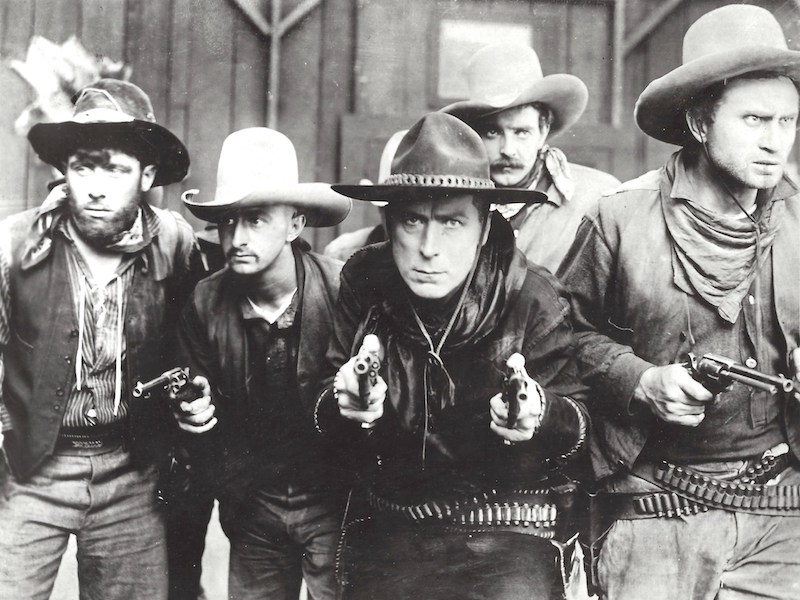THE GUNFIGHTER
William S. Hart (US 1917)
When I was given a 9.5mm home-movie projector, at the age of eleven, I acquired a handful of films to go with it. One was entitled The Outlaw – which I later found to be an abridged version of The Gunfighter. I was instantly captivated by the authentic atmosphere of this world, and it sparked a lifelong fascination with Hart.
Credit for direction on original prints went to Thomas Ince, even though Hart himself directed it. This was a habit of Ince’s, and it is small wonder the two men soon quarrelled.
It was customary to credit the scenario writer, but unusual at this period to acknowledge the art director. Robert Brunton had been production manager at Ince before specializing in art direction on such pictures as Peggy (1916). He eventually opened his own studio. The Gunfighter was shot at Inceville, Thomas Ince’s vast studio at what is now Pacific Palisades, where Hart had already made more than 30 films.
In the shooting script there is a note to cutting rooms: “244; advise 6 to 8 flashes of fire and panic – take from wealth of material taken of fire and panic during the making of HELL’S HINGES.” The script also says, at 238, “Burn one building – the saloon, smoke pot – and fake the rest”!
Hart’s cameraman was Joseph August, much admired in the business, who in 1935 would photograph John Ford’s The Informer. He was one of the founding members of the American Society of Cinematographers.
Margery Wilson, who played Brown Eyes in Griffith’s Intolerance, would soon become a director in her own right. In 1920 she directed and starred in a 5-reeler, That Something, and in 1922-23 she directed two more features. She was interviewed by Anthony Slide for his documentary Silent Feminists, in which she spoke of preferring to film in actual houses rather than on sets.
She plays Norma Wright, the town milliner, kidnapped by Cliff Hudspeth (Hart), an outlaw with a matchless reputation as a gunfighter. She has seen him in action, however, and condemns him as a cold-blooded murderer. Deeply shocked by her words, he knocks back a few glasses of whiskey and promises never to kill again. However, the authorities offer him a pardon if he will rid Arizona of El Salvador (Roy Laidlaw). When the bandit hears this, he burns the town and drags Norma to the mountains. Cliff rides in pursuit and kills El Salvador. But he is mortally wounded himself, and as Norma rides to safety, Cliff dies, consoled by the knowledge that he has killed only in her defence.
Bessie Love, who played with Hart in The Aryan, told me that John Gilbert was a bit player in The Gunfighter, along with Alice Taafe, a girl from the cutting rooms, later famous as Alice Terry.
Moving Picture World (10 February 1917) seemed to have a prejudice against westerns like these: “The story reverts to a role Mr. Hart ought to be thoroughly tired of, that of western tough whose soft spot is found by a woman of refinement.”
Kevin Brownlow
The Gunfighter started life as a 5-reel feature, but nothing like a complete copy has ever been found. Nine years after the film was made, Pathéscope issued a 9.5mm home-movie version running around 10 minutes. When 17-year-old Kevin Brownlow reviewed this in his monthly column in Amateur Cine World, he described it as a “much reduced version” of “a real collector’s item”. For decades, enthusiasts had no hope that they were going to be seeing any more.
There was also a separate 9.5mm version of the same length issued by Pathex in America – and because a different editor worked on this, they made different choices about what to leave in the drastically shortened home-movie release. The Pathex version lacked the opening of the gun being fired straight into the camera, but retained much more of the climax, with the night-time shootout. So it was already possible to create a slightly longer version by combining the two.
The breakthrough came when Kevin discovered that the Cinémathèque suisse had almost two reels of it on 35mm nitrate, tinted, with French titles. He also had a copy of the shooting script, complete with the list of English-language titles. He asked me whether it was possible to reconstruct the film based on these, including the two 9.5mm versions.
The reconstruction very broadly uses the Pathéscope version for the opening, the 35mm nitrate for the middle, and the Pathex release for the climax. All the titles have been recreated by Fritzi Kramer, based on the original title list. I have left the tinting, simple though it is, to match the nitrate, but added conjectural tints to the 9.5mm sections. It is still missing around two reels, but it is at least possible to get a fair impression of the quality of this film.
The reconstruction incorporates 9.5mm prints from Kevin, Dino Everett, and myself, scanned at the Hugh M. Hefner Moving Image Archive at USC. The nitrate was scanned by the Cinémathėque suisse.
Christopher Bird


regia/dir: William S. Hart.
scen: Monte M. Katterjohn.
photog: Joseph August.
scg/des: Robert Brunton.
cast: William S. Hart (Cliff Hudspeth), Margery Wilson (Norma Wright), Roy Laidlaw (El Salvador), J. J. Dowling (“Ace High” Larkins), Milton Ross (“Cactus” Fuller), J. P. Lockney (Col. Ellis Lawton), George Stone (Jimmy Wright).
prod: New York Motion Picture Corp./Kay-Bee, supv: Thomas H. Ince.
dist: Triangle.
uscita/rel: 11.02.1917; orig. l: 5 rl.
copia/copy: DCP, 30′, col. (da/from 9.5mm + 35mm, 19 fps, imbibito/tinted); did./titles: ENG.
fonte/source: Patrick Stanbury. Reconstruction produced by Christopher Bird and Kevin Brownlow.




